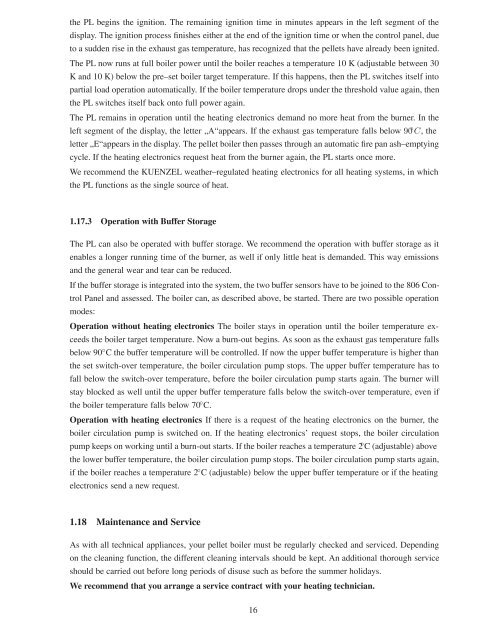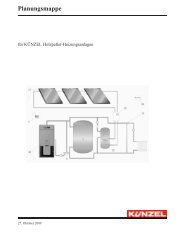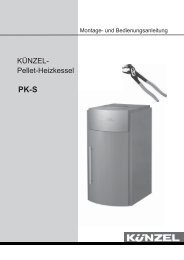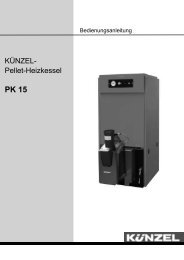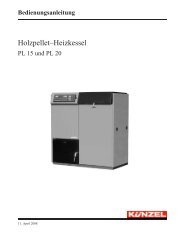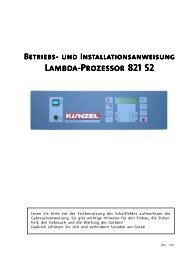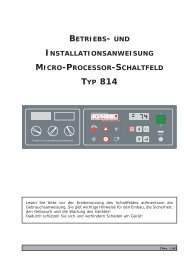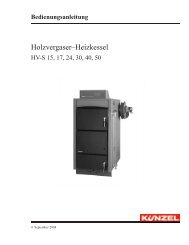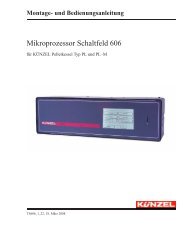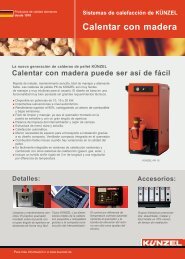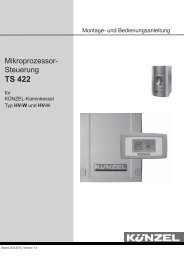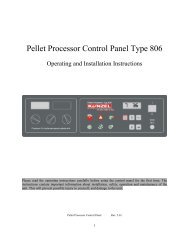pellets boiler - Paul Künzel GmbH & Co.
pellets boiler - Paul Künzel GmbH & Co.
pellets boiler - Paul Künzel GmbH & Co.
You also want an ePaper? Increase the reach of your titles
YUMPU automatically turns print PDFs into web optimized ePapers that Google loves.
the PL begins the ignition. The remaining ignition time in minutes appears in the left segment of the<br />
display. The ignition process finishes either at the end of the ignition time or when the control panel, due<br />
to a sudden rise in the exhaust gas temperature, has recognized that the <strong>pellets</strong> have already been ignited.<br />
The PL now runs at full <strong>boiler</strong> power until the <strong>boiler</strong> reaches a temperature 10 K (adjustable between 30<br />
K and 10 K) below the pre–set <strong>boiler</strong> target temperature. If this happens, then the PL switches itself into<br />
partial load operation automatically. If the <strong>boiler</strong> temperature drops under the threshold value again, then<br />
the PL switches itself back onto full power again.<br />
The PL remains in operation until the heating electronics demand no more heat from the burner. In the<br />
left segment of the display, the letter „A“appears. If the exhaust gas temperature falls below 90◦ C, the<br />
letter „E“appears in the display. The pellet <strong>boiler</strong> then passes through an automatic fire pan ash–emptying<br />
cycle. If the heating electronics request heat from the burner again, the PL starts once more.<br />
We recommend the KUENZEL weather–regulated heating electronics for all heating systems, in which<br />
the PL functions as the single source of heat.<br />
1.17.3 Operation with Buffer Storage<br />
The PL can also be operated with buffer storage. We recommend the operation with buffer storage as it<br />
enables a longer running time of the burner, as well if only little heat is demanded. This way emissions<br />
and the general wear and tear can be reduced.<br />
If the buffer storage is integrated into the system, the two buffer sensors have to be joined to the 806 <strong>Co</strong>ntrol<br />
Panel and assessed. The <strong>boiler</strong> can, as described above, be started. There are two possible operation<br />
modes:<br />
Operation without heating electronics The <strong>boiler</strong> stays in operation until the <strong>boiler</strong> temperature exceeds<br />
the <strong>boiler</strong> target temperature. Now a burn-out begins. As soon as the exhaust gas temperature falls<br />
below 90◦C the buffer temperature will be controlled. If now the upper buffer temperature is higher than<br />
the set switch-over temperature, the <strong>boiler</strong> circulation pump stops. The upper buffer temperature has to<br />
fall below the switch-over temperature, before the <strong>boiler</strong> circulation pump starts again. The burner will<br />
stay blocked as well until the upper buffer temperature falls below the switch-over temperature, even if<br />
the <strong>boiler</strong> temperature falls below 70◦C. Operation with heating electronics If there is a request of the heating electronics on the burner, the<br />
<strong>boiler</strong> circulation pump is switched on. If the heating electronics’ request stops, the <strong>boiler</strong> circulation<br />
pump keeps on working until a burn-out starts. If the <strong>boiler</strong> reaches a temperature 2◦ C (adjustable) above<br />
the lower buffer temperature, the <strong>boiler</strong> circulation pump stops. The <strong>boiler</strong> circulation pump starts again,<br />
if the <strong>boiler</strong> reaches a temperature 2◦C (adjustable) below the upper buffer temperature or if the heating<br />
electronics send a new request.<br />
1.18 Maintenance and Service<br />
As with all technical appliances, your pellet <strong>boiler</strong> must be regularly checked and serviced. Depending<br />
on the cleaning function, the different cleaning intervals should be kept. An additional thorough service<br />
should be carried out before long periods of disuse such as before the summer holidays.<br />
We recommend that you arrange a service contract with your heating technician.<br />
16


